The scheduled topic for today’s journal was Pt. Barrow or Nuvuk History #2. The historic information is critical to understanding the lives of the Inupiats and their culture. At the same time, the information comes across as something of a lecture. Today, a break to explain the excavation I did today.
Quick Note: The Inupiat people have requested that no one photographs the human remains. We are very careful to transport the remains in special plastic bags and closed containers to respect the wishes of the native people.
Try to imagine: Many, many years ago, a windy, cool day in mid-summer out at Nuvuk. The seas are quiet, the ice floats lazily by, the sun flows in and out of the fog. The community has gathered to honor the spirit of an older member of the village who passed away recently. A fine resting spot is chosen up on the highland, just south of the village. A depression is dug down through the grass and into the gravel using bone tools. Driftwood pieces and whalebone are gathered by family members and used to mark the outline as well as hold up the sides of the site. The deceased is carefully placed in the burial, following the outline of the land; head to the northwest, feet to the southeast. Stories are told, songs are sung, tributes are left, and a family grieves. The body is covered with more whalebones, driftwood, and finally tundra grasses. The wind blows, the waves roll upon the shore, and gulls fly by.
This fictional burial story is designed to show how an Inupiat might have been laid to rest. An archaeologist attempts to clarify the above story, making it more accurate and based upon well-documented research, not a few discussions and a single burial site excavation.
My work today was excavating a site that was believed to include human remains. (HR) We are quite respectful of the person, the ancestors, and the remains as we do this work. A quiet falls over the group of us as we begin.
How did we know where to start? We determine where to excavate human burials based on one of three techniques. The first technique, is the "Oh Wow, Look Everyone, I Found a Bone Sticking Out of the Ground Technique.” In this technique, someone notices a piece of bone, it is identified as human remains, and we assume that there is a burial nearby. The picture below is of animal bones, not human remains.
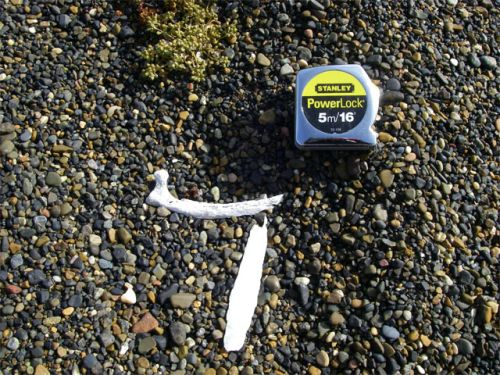 This is an example of the "Oh Look, I Found, …. " Technique for finding human burial sites.
This is an example of the "Oh Look, I Found, …. " Technique for finding human burial sites.
The second technique is the "Shovel Test Pit Technique.” This technique starts with a digger, shoveling along an established line, and the digger finds something and the first technique take over.
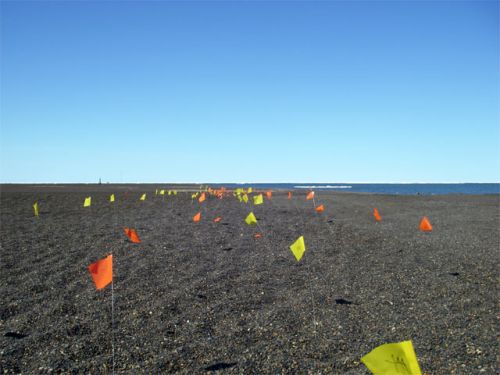 This picture was used before, it gives a nice overview of how the test pits go on for some distance, alternating along the way.
This picture was used before, it gives a nice overview of how the test pits go on for some distance, alternating along the way.
The third technique is the "I Think We Should Dig Here Technique.” This strategy requires different skills than the first two. We look for mossy, grassy, areas, which indicate that something once living is under the surface, providing nutrients for the plants.
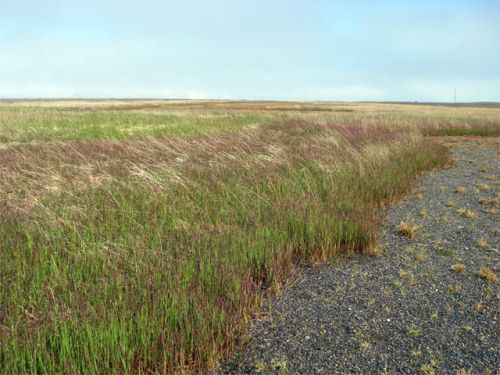 The Point has been impacted by four-wheelers and trucks. The once abundant tundra grass is gradually disappearing. We are not helping it though, we drive out there everyday and have to work through some of the organic remains. These grasses and plants were used in their houses as insulation and in other ways.
The Point has been impacted by four-wheelers and trucks. The once abundant tundra grass is gradually disappearing. We are not helping it though, we drive out there everyday and have to work through some of the organic remains. These grasses and plants were used in their houses as insulation and in other ways.
Once the site is determined, the excavation begins as a sketch of the site is made. Gravel and soil are reviewed from the top. We use trowels, dustpans and buckets for this part. When bones or wood pieces are uncovered, we switch to softer tools such as paint brushes or wooden picks. After each sweep of the tool, we look. What is it? How big is it? Does it show signs of human working, in other words, has it been notched or broken by humans? We continue. Notes are written to explain what we are seeing. Once we have cleared a layer of material, we make a "3D map” of it using the transit.
We continue, gradually but efficiently, removing material, layer by layer. More info becomes available as burial rocks are found, lots of burial rocks. This is looking promising. Add notes. A large piece of wood emerges, more whalebone noticed. Bones of birds and small mammals are encountered. Look a piece of pottery!! A sizable piece, well made for around here. More notes, more pictures, more shoots with the transit. Two sites become visible!! Remove gravel, look close, a piece of broken slate, chipped on two sides. Wow!! Teeth, what kind, they are worn, must be …. Fox. Mark it, shoot it, bag it, ….
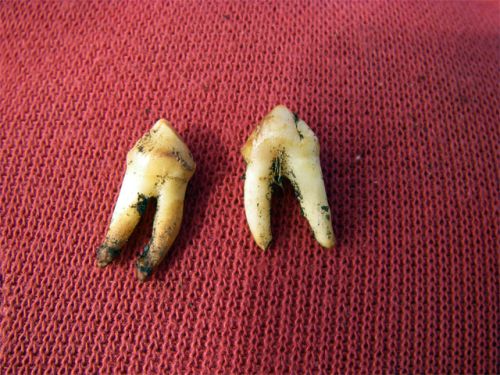 These two fox teeth were uncovered in our burial area. Very well preserved but very well worn too. I wonder if that meant that the fox was old? I'm becoming an archaeologist!!
These two fox teeth were uncovered in our burial area. Very well preserved but very well worn too. I wonder if that meant that the fox was old? I'm becoming an archaeologist!!
We continue until lunch. Enthusiasm slipping, we have removed most of the dark, rich organic material, lots of promising signs, no human remains. After lunch, we shoot a few more pieces. Move more material, back to gravel, … Final shoots, no human remains. Oh well, that’s how it goes sometimes. 90+ pieces of animal bone, whalebone, wood fragments, rocks and a piece of pottery all labeled, mapped, and recorded. They head to the lab at the end of the day for further examination. We head for the shovels to put the gravel back over the top of this site.
That’s how it goes sometimes. We learn from all the work we do, no matter what we find. Meanwhile over at the trench, great progress has been made. The trench is now deep enough and has hit permafrost (frozen ground) in some areas. It’s a remarkable accomplishment. Many of us commented on the discipline and the efforts required by the soldier in World War I to build and maintain their trenches.
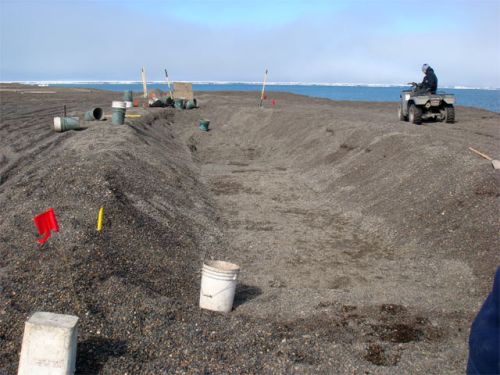 It took 2.5 days with a crew of over 10 people to get this trench dug. Excavation will be a little slow due to the frozen ground know as permafrost. An impressive trench!! Thanks to Dave G. for the photo.
It took 2.5 days with a crew of over 10 people to get this trench dug. Excavation will be a little slow due to the frozen ground know as permafrost. An impressive trench!! Thanks to Dave G. for the photo.
Tomorrow, Bones 101 with some tool pictures. More pictures, less explanation. Thanks for reading, asking questions and being a part of this adventure!!

